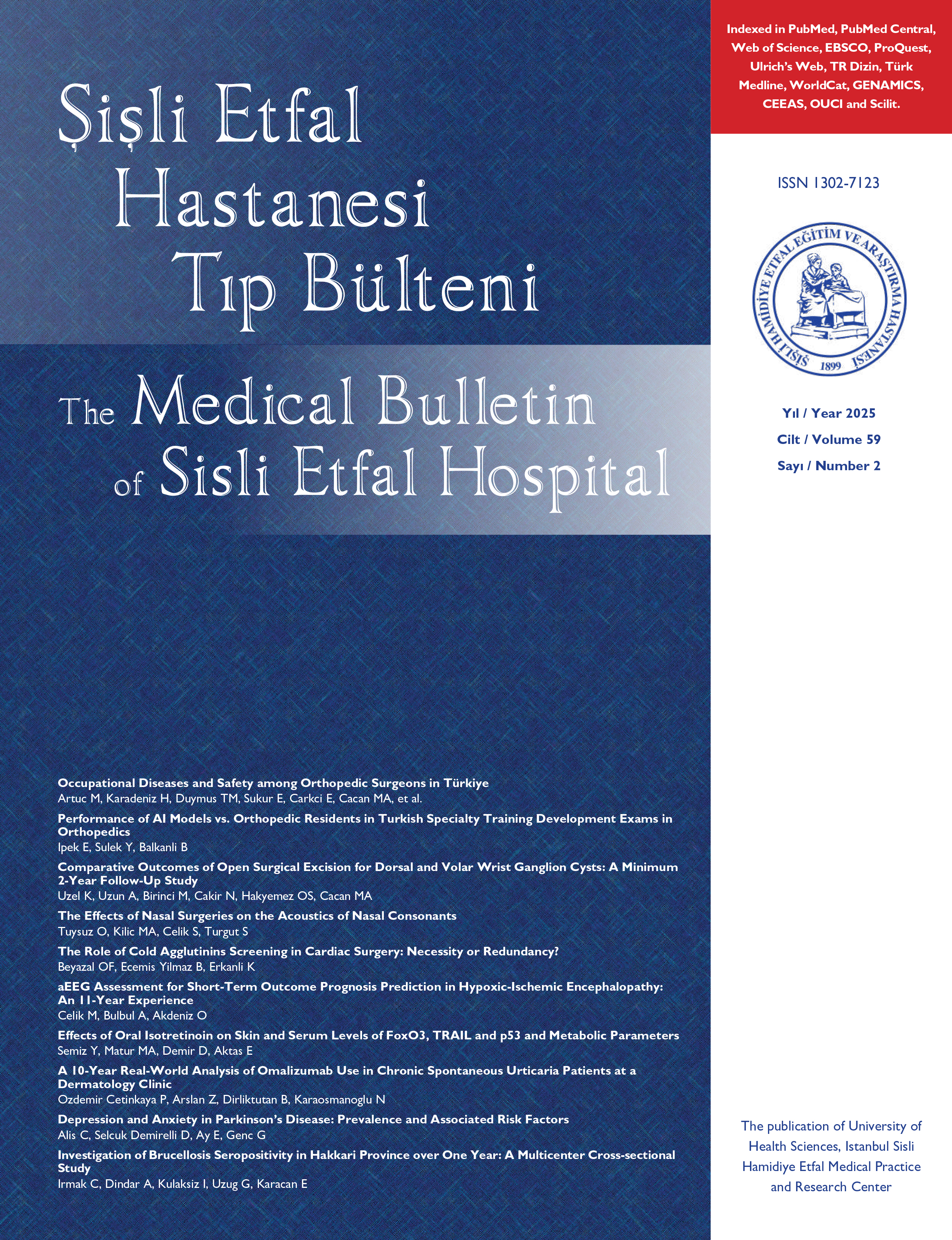
Volume: 46 Issue: 1 - 2012
| ORIGINAL RESEARCH | |
| 1. | The effect of pentoxifylline on doxorubicin induced extravasation injury Medeni Volkan Kıyak, Ayşin Karasoy Yeşilada, Mehmet Oğuz Yenidünya, Fulya Öz Puyan Pages 1 - 7 Objectives: Extravasation injury is characterized by leakage of pharmacologic or non-physiologic substances from the vessel into the tissue, causing destruction. Full-thickness skin necrosis after extravasation of the widely used chemotherapeutic agent doxorubicin, is a significant source of morbidity in cancer patients. This progressive tissue necrosis may lead to pain, ulceration and disfiguring tissue loss. Although, various treatment options have been proposed for this type of injury, there is no consensus regarding the management of such lesions. The aim of this study was to determine the effectiveness of pentoxifylline and the relationship between usage duration and efficiency of the drug as a treatment in a rat extravasation model. Study Design: The study was done on forty Wistar-Albino rats, weighing 300 to 350 g, All rats received 1 mg of doxorubicin in 1 cc of saline intradermal flank injection to stimulate extravasation injury. The rats were divided into three groups and intraperitoneal pentoxifylline of 50 mg/kg/day was administered within 12-hour intervals. Group1: they got the treatment on the same day with the injury (n=10). Group 2: they got the treatment 1 day after the injury (n=10). Group 3: Control group (saline infusion was administered). At the end of seventh, tenth, twelfth and fifteenth days, the size of ulcers at the injection site were calculated via Planimetri ® software image analysis program. A biopsy specimen, including all necrotic tissue and surrounding healthy tissue, was obtained at the end of the fifteenth day. Results: In groups 1and 2 there were statistically significant differences in the sizes of necrosis compared with control group (P<0,01). In group 1 and 2, these was not statistically significant difference. Area of necrosis in Group 1 was similar to that in Group 2. Conclucion: The data suggest that pentoxifylline is effective in the treatment of doxorubicin induced extravasation injury when administered on the day of and after doxorubicin injection. |
| 2. | Retrospective analysis of treatment approach of patients diagnosed with acute pancreatitis Gülen Tandoğan, Belkıs Nihan Coşkun, Ayça Eroğlu, Duygu Nurdan Avcı, Kader Irak, Murat Kıyıcı Pages 8 - 15 Aim: The aim of this study was to evaluate the approaches to the treatment of patients who are followed with diagnosis of acute pancreatitis (AP). Patients and Methods: Total of 184 patients, diagnosed with AP in our hospital between 2005-2010 were assessed retrospectively. Demographic characteristics, etiologic findings, disease severity, treatment modalities, duration of fasting, the use of antibiotics, given the total amount of daily hydration, duration of parenteral nutrition, pain treatment, prognosis and hospital stay were recorded. The relationship between treatment and the length of hospital stay and between treatment and mortality were examined. The disease were divided into mild and severe stage according to the clinical severity. Results: Complications developed in 27 patients (14.7%). Peripancreatic fluid accumulation in 10 patients (5.4%), pseudocys in seven patients (3.8%), pancreatic abscess in one patient (0.5%), acute renal failure in 10 patients (5.4%), and hypotension and shocked in three patients were observed. The mortality rate was 3.8% (7 cases). Antibiotic therapy was given to146 patients (79.3%) and there was no significant difference in terms of the duration of hospitalization and mortality rates between the groups of patients treated with treated with antibiotics, and not treated with antibiotics (p= 0.077, p= 0.557). When the patients who did and did not receive TPN were compared, Patients with severe cases of AP were received significantly more TPN. On the other hand, when discontinuation of oral intake and duration of hospitalization and mortality rates were compared, there was no significant difference (p= 0.182, p= 0.54). Conclusion: AP is an important clinical problem which can be mortal. There are still many controversial treatment methods. Since empirical use of antibiotics does not affect patients length of hospitalization and mortality, it has been recommend only in ed cases. The treatment of enteral or parenteral nutrition therapy should be chosen according to the severity of disease. |
| 3. | Short-term outcomes of triple pelvic osteotomy in adult patients with acetabular dysplasia Ümit Tuhanioğlu, Nurullah Ermiş, Yavuz Arıkan, Akif Albayrak, Eyüp S. Karakaş Pages 16 - 25 Objectives: The goals of surgery are to reorient the biomechanical relationships such that the development of degenerative hip disease is delayed or prevented. To achive these goals, various pelvic osteotomies have been used. We preferred the Steel Triple Innominate Osteotomy to treat acetabular dysplasia. Materials and Methods: During the period between November 2003 and March 2007, triple innominate osteotomy was performed on 30 patients and 31 hips. There were 27 women and 3 men. The average clinical follow-up was 24.1 months (range 12-52 months). The average age at surgery was 31.1 years (range 16-52 years). Results: Preoperative hip score increased from an average 64.3° preoperative to 82.9° postoperative. The CE angle was increased from an average 5.42° preoperative to an average 24.52° postoperative. The VCE angle was increased from an average 8.94° preoperative to an average 29.1° postoperative. The Sharp angle was decreased from an average 50.71° preoperative to an average 37.68° postoperative. The Tönnis angle was decreased from an average 22.32° preoperative to an average 11.52° postoperative. The percentage of the femoral head covered by the acetabulum increased from 59.23% to 79.77%. These parameters were significant statistically (p<0.05). Anteversion was 20.39° preoperative and 19.84° postoperative. Acetabular index of depth and width changed from 27.97° preoperative to 28.39° postoperative. Lateralization was 20.32 mm. preoperative and 21,81 mm postoperative. These parameters were not statistically significant. The complications were implant failure in two patients, deep infection in one patient, and hematoma in one patient. Conclucion: As a result of this experience, we concluded that the Steel Triple Innominate Osteotomy is a safe and succesful treatment method that is helpful for patients with mild to moderate dysplasia. |
| CASE REPORT | |
| 4. | Octreotide treatment in neonatal chylothorax: a case report Muhittin Çelik, Ali Bülbül, Sinan Uslu, Nihat Sever, Emrah Can Pages 26 - 29 Chylothorax is defined as accumulation of chylous fluid in pleural cavity which may be caused by congenital and acquired diseases. During neonatal period, chylothorax treatment is composed of conservative( pleural drainage, termination of enteral feeding, total parenteral nutrition and supplementation with medium-chain triglycerides) and surgical therapies(ductus thoracicus ligation, pleuredesis). Nowadays, for cases among which conservativ therapies fail, treatment with octreotide has been reported to be beneficial with promising results. A neonate who developed chylothorax after congenital diaphragmatic hernia operation and who was successfully treated with octreotide after failure of conservative treatment is presented in this case report. |
| 5. | Gastric metaplasia in gallbladder; case report and review of the literature Uğur Kesici, Sevgi Kesici, Sezgin Zeren, Ülkü Aygen Türkmen, Mehmet Çimen, Gülen Burakgazi Pages 30 - 32 Purpose: Gastric metaplasia is an epithelial change in gallbladder, seen at patient with gallstones. In this case presentation, the significance of gastric metaplastic lesion is discussed. Case Presentation: In this case report, 34 years old female with a pain complaint in right upper quadrant, that arised especially after fatty food, is discussed and literature is evaluated. Multiple calculi - the greatest is 1 cm - were determined in gallbladder in the abdominal ultrasonography. Laparoscopic cholecystectomy was performed under elective conditions. Gastric metaplasia in gallbladder was determined in pathological examination. Conclusion: It is stated that metaplasia-dysplasia sequence in gallbladder may be the beginning of gallbladder cancer. For this reason, we consider that histopathological examination of gastric metaplastic lesions in gallbladder should be performed more carefully |
| 6. | Methemoglobinemia due to prilocaine use during circumcision: a case report Pınar Sayın, Şebnem Türk, Oya Ünsal, Ulviye Hale Dobrucalı, Eren Açık, Ayşe Hancı Hancı Pages 33 - 35 Prilocaine is a local anesthetic agent that using in various fields of medicine. Besides its widespread use it has a potentially life treating complication methemoglobinemia. Methemoglobinemia is presented with varying degrees of cyanosis. In these cases hemoglobin concentration which contains oxidized iron increased. This hemoglobin is insufficient to carry out the oxygen. In this case report we discussed one male infants (4 months age) who developed cyanosis after circumcision. Infant was an anesthetized with local prilocaine. Central cyanosis appeared six hour after surgery. The methemoglobine level reached to 23%. Subject was interned to intensive care unit and ascorbic acid therapy as well as O2 therapy with mask was started. The subjects sPO2 levels were %88 with the O2 therapy with mask. The cases methemoglobine levels was decreased to 12, 3% in 12th hour and 1,3% in 24th hour postoperatively. 24 hours after surgery, subject was discharged from intensive care unit. No additional complication was observed. İn this presentation; cases features and methemoglobinemia due to prilocaine use are discussed in the accompaniment of the literature. |
| REVIEW ARTICLE | |
| 7. | Fluid and electrolyte homeostasis in neonatal period Ali Bülbül, Sinan Uslu Pages 36 - 42 Water and electrolyte homeostasis in newborn infants is different from adults and other childhood ages. This homeostasis is affected by physiologic adaptations following birth. Physiologic adaptations include distribution of total body water and water loss. Caring for the newborn and prematurity in the NICU requires knowledge and understanding of the physiologic adaptation to extrauterine life and how prematurity affects that transition. Clinicians play an integral role in managing fluid and electrolyte balance in these infants. This review addresses postnatal adaptation and all aspects of fluid and electrolyte management of the term and preterm infant. |



















